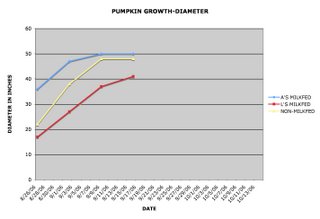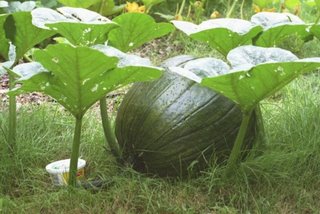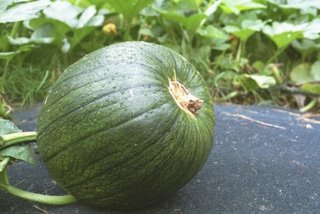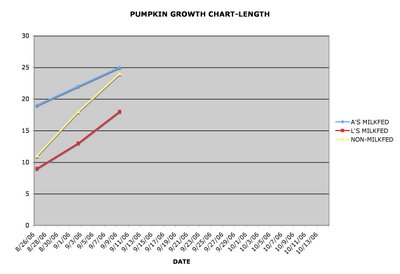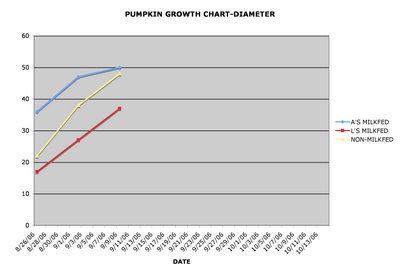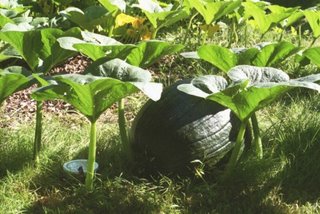We had a pumpkin. Close inspection revealed that we had not just one, but three. One rather large one, and two smaller ones.
All larger than Almanzo's when he began, but let's remember, he was "Farmer Boy." We're just garden-diddlers out here in the 'burbs of Northwest Indiana.
If we were going to grow a milk-fed pumpkin, we had no time to lose.
First, a quick check with the source:
"Father had shown him how to raise a milk-fed pumpkin. They had picked out the best vine in the field, and snipped off all the branches but one. Then between the root and the wee green pumpkin they carefully made a little slit on the underside of the vine. Under the slit Almanzo made a hollow in the ground and set a bowl of milk in it. Then he put a candle wick in the milk, and the end of the candle wick he put carefully into the slit.
Every day the pumpkin vine drank up the bowlful of milk, through the candle wick, and the pumpkin was growing enormously. Already it was three times as big as any other pumpkin in the field" (Wilder, *Farmer Boy*, 191-2).
Okay, there are a number of problems with these instructions:
1) our pumpkin is not a "wee green" thing but already a good 30" in diameter.
2) if you've ever grown pumpkins (this was my first time) the task of "snipping off all the branches but one" is rather formidable: we have an enormous tangle of very SPINY vines in our bed, & figuring out which branch belongs to which vine will take more time and energy than this full-time-employed mom will ever have.
3) we are organic, and I'll be damned if I'm going to feed a pumpkin milk that costs $8.20/ gallon (more than any other liquid we consume, including both gas and liquour!)
4) who the hell has candle wicks lying around the house these days? (yeah, probably all you scrapbookers out there...)
Fortunately, we have something Manley didn't--the internet(s). Taking instant advantage of our newly installed high speed internet connection (WIRELESS, no less!) I quickly find both a solution to some of these problems and--a challenge.
From
www.oldhouseweb.com/gardening:
"Gardeners occasionally try to grow giant pumpkins using the "milk-fed" method. This technique is an old-time favorite (probably more myth than fact) which can be tried. Pick out the healthiest vine in the garden, trim off all side shoots. Let one pumpkin form to softball size, and trim off all other flowers. Cut into the vine with a knife about 3 inches down from the fruit. Do not cut through to the other side of the vine. Insert a candlewick, at least 1/4 inch into the vine, through the slit. Place a bowl of milk or sugar water in a depression beside the pumpkin. Place the other end of the wick into the bowl. Fill the bowl with milk or 1 cup of water mixed with 1 Tablespoon sugar. Cover the bowl with plastic to keep out bugs and dirt. Check it everyday. Make sure the milk does not go sour or the wick fall out of the vine. Refill liquid when it is gone. Keep feeding the fruit this way until harvest. It should be gigantic!"
Probably more myth than fact, eh? Well, we're going to settle that question once and for all!!
We decide not to worry about initial size (softball, schmoftball); choose the sugar water method (thank you, internet!); use plastic sour cream containers with a little hole in the lid (both Big Sister and Little Sister are squeamish about bugs); and, in lieu of candle wicks, we do some quick experimenting on the wicking ability of several different strips of cloth until we find what seems to be a suitable alternative.
August 26, 2006: the experiment begins. Each little girl has a milk-fed pumpkin, and there is one "control." Since the pumpkins are all different sizes when we start, rate of growth rather than final size will have to be the determinant of whether or not the milk-fed method is "more myth than fact."
I'll let my more scientifically-oriented readers (that would be you, Eric) critique our methodology.
Here is our initial data: (L=Length; D=Diameter; I realize W=Weight is a usual measure of pumpkin growth and size, but we don't own a scale...)
Milk-Fed Pumpkin "A": 19" L/ 36" D
Milk-Fed Pumpkin "L": 9" L/ 17" D
Non-Milk-Fed-Pumpkin: 11" L/ 22" D
If I can figure out a way to a) make and then b) upload a chart to this blog, you'll be seeing rate of growth charts in the next couple of postings....






